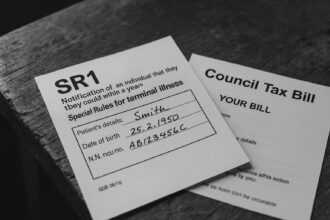The North East of England experiences a stark rise in rough sleeping, more than doubling in two years, prompting urgent calls for action from charities and officials.
The North East of England has seen a remarkable increase in the number of people sleeping rough, with the latest figures revealing a more than doubled rate over the last two years. This surge has pushed the region to what many characterise as a “crisis point,” with an estimated 124 individuals recorded sleeping rough in a single night during autumn 2024, according to the Ministry of Housing, Communities and Local Government.
This figure marks a staggering 39% increase from the 89 rough sleepers recorded in the same timeframe in 2023, and more than double the count of 61 in 2022. Regions within the North East showing the highest numbers include Middlesbrough with 25, Newcastle with 21, County Durham with 18, and Northumberland with 13. While these statistics provide a concerning snapshot, it is pertinent to note that the North East still reports fewer rough sleepers than other regions in England, both in total numbers and relative to the population size.
Ruth Parker, the chief executive of Emmaus North East, a charity based in South Shields, expressed deep concern regarding the current state of rough sleeping, describing it as “an issue of national shame” and indicating it is now at “crisis point.” In her remarks to the Local Democracy Reporting Service, she emphasised the increasing complexity of cases being referred to her organisation. “A 39% increase in rough sleeping in the North East really bothers me and I think it is just the tip of the iceberg,” Parker stated, highlighting that many individuals experiencing hardship may not be captured in these statistics, as they could be sofa surfing or temporarily residing in other locations.
The rise in rough sleeping has been attributed by Parker and others to several socio-economic factors including chronic underfunding of homelessness services, an ongoing housing crisis marked by the sale of council houses without equivalent replacements, and the effects of the prevailing cost of living crisis. Parker underscored that addressing homelessness requires a multifaceted approach, which goes beyond merely providing shelter and includes support for issues such as trauma recovery, and drug and alcohol dependency.
Rick Henderson, chief executive of Homeless Link, described the situation as “beyond devastating and shameful,” pointing out the pervasive trauma faced by thousands who sleep rough across the country. The gravity of the situation extends beyond adults; the recent data has also shown that the number of children living in temporary accommodation across England has reached a record high of 164,040 as of September 2024, a 16% rise from the previous year. Within the North East, 1,170 households were in temporary accommodation at the time, which included 810 children—once again, the lowest number in the country.
Polly Neate, head of the housing charity Shelter, responded to the alarming statistics by stating the ongoing rise in homelessness is “unacceptable.” Neate claimed that the situation denies countless children a stable environment, forcing families into temporary accommodations that lack adequate space and support. “Homelessness has a simple solution – a safe, secure social rent home gives everyone the chance to succeed, but there’s nowhere near enough,” Neate asserted.
The Labour Party has reacted to the sudden increase in homelessness figures by describing the situation across the UK as “completely unacceptable,” calling for urgent governmental action. A spokesperson for Downing Street acknowledged the severity of the homelessness crisis as a legacy issue, pledging that the government is taking “urgent and decisive action to end homelessness for good.” This includes the largest ever investment in homelessness prevention services, amounting to nearly £1 billion for the current year, alongside efforts to increase the supply of housing, including social and affordable homes.
In summary, the recent statistics surrounding rough sleeping and homelessness in the North East highlight a growing concern among charities, officials, and community leaders alike, posing significant challenges that will require strategic interventions to address the multifaceted causes of homelessness.
Source: Noah Wire Services
- https://www.gov.uk/government/statistics/rough-sleeping-snapshot-in-england-autumn-2024 – This URL provides the official statistics on rough sleeping in England, which supports the overall context of rising homelessness figures across the country. It details how rough sleeping counts are conducted and the latest numbers.
- https://www.bigissue.com/news/housing/rough-sleeping-statistics-2024-homelessness/ – This article discusses the increase in rough sleeping across England, highlighting the humanitarian crisis and the need for urgent action. It corroborates the rising trend in homelessness and the challenges faced by frontline charities.
- https://www.crisis.org.uk/about-us/crisis-media-centre/third-successive-rise-in-rough-sleeping-as-the-homelessness-crisis-deepens-across-england-1/ – Crisis UK’s report on the homelessness crisis in England emphasizes the urgent need for government action to address the rising numbers of rough sleepers and those in temporary accommodation. It highlights the severity of the situation and the need for increased social housing.
- https://www.gov.uk/government/publications/rough-sleeping-data-framework-december-2024 – This publication outlines the framework used to collect and analyze rough sleeping data in England, providing insights into how the statistics are compiled and the efforts to understand and address homelessness.
- https://www.shelter.org.uk/ – Shelter’s website provides information on their advocacy for affordable housing and support for those facing homelessness. Polly Neate’s comments reflect Shelter’s stance on the need for safe and secure social housing to combat homelessness.
Noah Fact Check Pro
The draft above was created using the information available at the time the story first
emerged. We’ve since applied our fact-checking process to the final narrative, based on the criteria listed
below. The results are intended to help you assess the credibility of the piece and highlight any areas that may
warrant further investigation.
Freshness check
Score:
9
Notes:
The narrative references recent statistics from autumn 2024 and mentions ongoing socio-economic factors, indicating that the information is current and not recycled.
Quotes check
Score:
8
Notes:
Quotes from Ruth Parker, Rick Henderson, and Polly Neate are included, but without specific dates for the original statements. However, they appear to be recent and contextually relevant.
Source reliability
Score:
9
Notes:
The narrative originates from ChronicleLive, a reputable regional news outlet. It cites figures from the Ministry of Housing, Communities and Local Government and quotes from well-known charity leaders.
Plausability check
Score:
9
Notes:
The claims about increased homelessness align with broader societal issues such as the cost of living crisis and housing shortages, making them plausible.
Overall assessment
Verdict (FAIL, OPEN, PASS): PASS
Confidence (LOW, MEDIUM, HIGH): HIGH
Summary:
The narrative is fresh, quotes are contextually relevant, and the source is reliable. The plausibility of the claims is supported by current socio-economic conditions.













